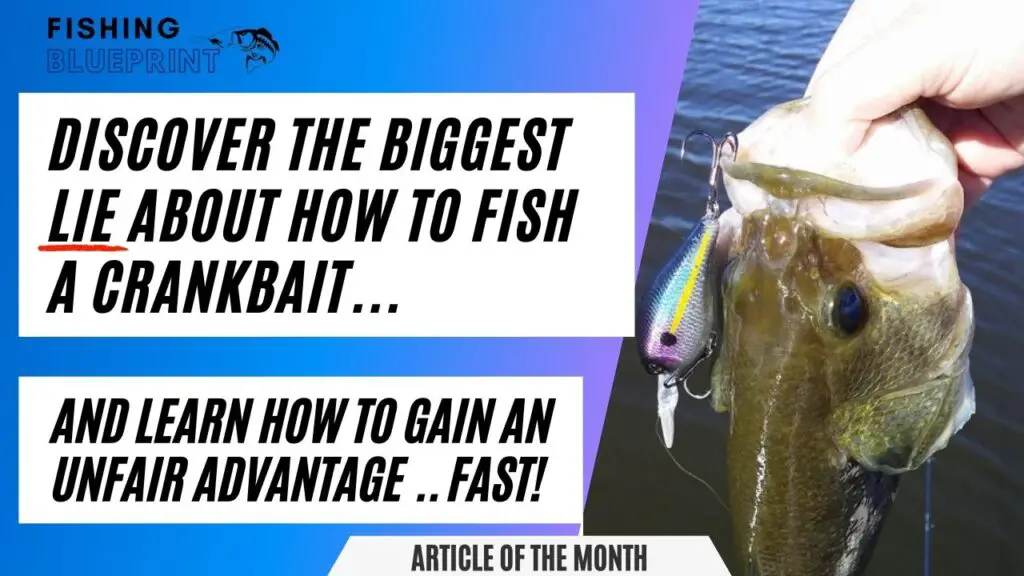How To Fish Lake Piru
Lake Piru Fishing Report
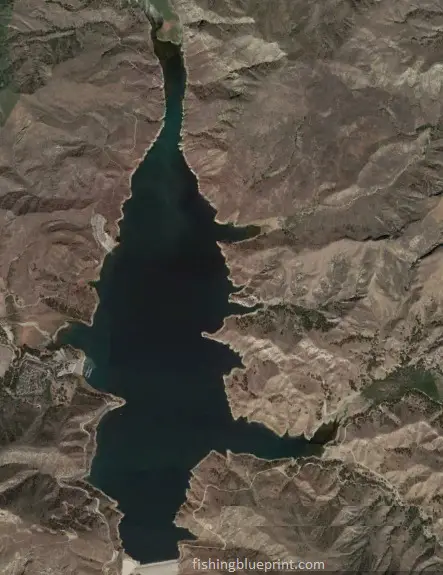
Lake Piru is a moderate size lake that sits 56 miles north of Los Angeles and 365 miles away from San Francisco.
Overall it’s a popular lake and is known for its largemouth bass, crappie and trout fishing. In this post you’re going to be given the blueprint to fish this lake.
So what are the best tips for fishing Lake Piru? There are three important factors you must know if you want to know how to fish Lake Piru successfully. First, you need to know what kind of fish is in Lake Piru. Second, it’s important for you to know which part of the lake each species can be found. Lastly, knowing what are the best baits that work on Lake Piru is vital. However, tactics, baits, and locations will be different for each type of fish that you target. So let’s talk about the steps you need to take in order to give you the best chance of catching a fish on Lake Piru.
About Lake Piru
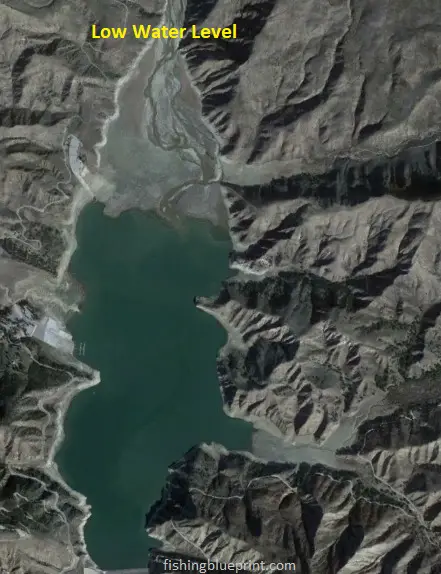
Lake Piru is a moderately deep body of water with the average depth being 60 feet and a maximum depth of 165 feet when the lake is completely full. However, in recent years the water level has been very low.
Fishing Lake Piru can be absolute gangbusters when you have over 22 miles of shoreline to fish.
The primary game fish species are largemouth bass, crappie, sunfish, catfish, and planted rainbow trout.
Important Lake Warnings
Algae blooms may be present which may affect fishing, swimming, and water contact in general.
According to parks.ca.gov, “every one of California’s new laws requires boat operators to have a California Boating Card. The card is required for anyone under the age of 41 to operate a boat in California’s waters.”
If you are fishing and camping, fire bans may be in effect due to the ongoing drought conditions.
What Kind Of Fish Are In Lake Piru
- Rainbow Trout
- Largemouth Bass
- White and Black Crappie
- Bluegill and Sunfish
- Catfish
Lake Piru Fishing Tips & General Strategies
Lake Piru is a moderately deep body of water with the average depth being 60 feet and a maximum depth of 165 feet when the lake is completely full. Fishing Lake Piru can be absolute gangbusters when you have over 22 miles of shoreline. to fish.
The primary game fish species are largemouth bass, smallmouth bass, crappie, sunfish, catfish, planted rainbow trout and brown trout.
Springtime Fishing update
Lake Temperature:
The water temperature typically has been ranging from 50-degrees in early spring to 78-degrees late spring.
Water Clarity:
The water clarity also ranges from muddy (0-2 foot visibility) to clear (4+ foot visibility).
Fishing Techniques:
Dropshotting with small tubes in the 25-foot range near any bend in the creek channels or on points was a popular technique. Slow presentation and finesse were emphasized by many anglers. Deep diving cranks produced the most for anglers who are willing to fish deep structures. Others recommended split shotting finesse plastics.
Trout anglers have been catching them trolling with Kastmasters, needlefish, and small minnow-style Rapalas.
Overall, it seems like dropshotting, finesse techniques, and trolling with smaller lures were effective during the spring months.
Lake Piru- Summer Fishing update
Hello, fellow anglers! Here’s your summertime report:
Summer Fishing Report for Lake Piru (June-September)
Average Temperature:
70-80 degrees Fahrenheit
Average Water Clarity:
Clear (4+ foot visibility)
Techniques Used:
- Topwater lures: Anglers have reported success with topwater lures such as Zara Spooks and buzzbaits during the early morning and late evening hours.
- Soft plastics: Texas-rigged worms and creature baits have been effective in deeper water near drop-offs and points.
- Crankbaits: Shallow- and medium-diving crankbaits have been productive along rocky shorelines and in coves.
- Jigs: Football jigs and finesse jigs have been successful on rocky points and ledges.
- Dropshot: Dropshotting with small finesse worms or minnow imitations has been effective in deeper water.
Lures used:
- Topwater lures: Zara Spooks, buzzbaits, poppers
- Soft plastics: Zoom Trick Worms, Senkos, Zoom Brush Hogs
- Crankbaits: Strike King Squarebill, Rapala Shad Rap, Bomber Fat Free Shad
- Jigs: Strike King Football Jig, finesse jigs
- Dropshot: Roboworms, Zoom Flukes
Wind and Weather:
During the summer months, anglers can expect hot and dry weather with occasional gusts of wind. The wind can be a factor in fishing, making it difficult to control the boat or cast accurately. It is important to pay attention to the weather forecast and plan accordingly, bringing plenty of water and sunscreen. Fishing during the early morning and late evening hours can be more comfortable and productive in the summer heat.
But Where Are The Best Places To Fish At Lake Piru?
And in no particular order here is that list of the best fishing spots at Lake Piru.
DISCLAIMER: The material provided is for general information purposes only. It’s important to understand that any information provided in this article can change at any time. Any maps or graphics featured are not to be used as navigational aids. Fishing Blueprint will not be responsible for any personal injury or property damage from any misuse of the maps or graphics provided. It’s completely impossible to give you every single spot where you can potentially catch a fish. But, what this list does do is to give you a helping hand and narrow down to the most productive fishing spots.
Santa Felicia Dam
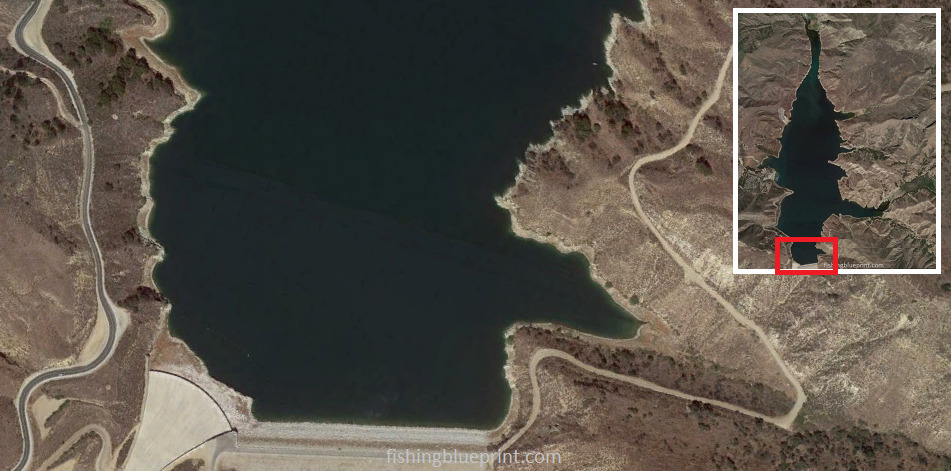
Fishing just outside the buoy line of the dam can catch you an abundance of coho salmon, lake trout, rainbow trout, and even some brown trout.
If the water is low, graph the cove just to the north of the dam and you can find bass and crappie suspended over submerged trees and rocky shelves.
This section of the lake can get very windy. And even with the best trolling motor the wind can quickly blow you off your spot which will significantly decrease your chances of catching a fish..
That is why we strongly suggest buying a quality drift sock. For those who don’t know, a drift sock is like a parachute for the water. If it’s breezy to windy, you need to slow your drift otherwise your lure will not be in the strike zone long enough to catch a fish.
Located: south lake
Structural features: steep rocky bank
Best species to target: trout, largemouth bass, catfish, crappie
Most effective way to fish this spot: boat, kayak
Santa Felicia Cove
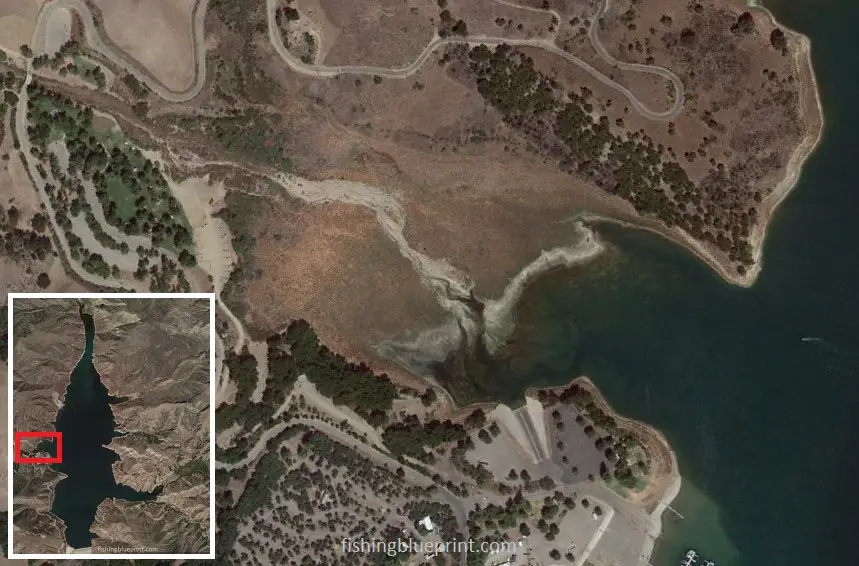
This long straight cove has a deep channel fed by several feeder creeks.
A really great feature about this cove is there is one main creek channel that runs down the middle of it, however there are several other ditches (smaller secondary creek channels) that run into it, kinda like a leaf.
Due to the extremely low water levels large amounts of grass, brush, and small trees have grown where the lake water once held. Fortunately, this provides much needed cover for smaller fish and young bass to seek shelter.
Scan the intersections for ledges, drop offs, boulders, rock piles, ridges associated with the two intersecting channels.
Lastly, a tire reef has been placed at the mouth of the cove on the north side.
Located: south lake
Structural features: submerged and emergent brush and trees, artificial structure.
Best species to target: trout, largemouth bass, catfish, crappie
Most effective way to fish this spot: boat, kayak
Reasoner Cove

This area is a relatively shallow cove and its banks are lined with flooded brush and small trees. It has a relatively large creek channel with multiple smaller drainage ditches that feed into the primary creek channel. These intersections should be scanned and can hold fish all year long.
This cove is known to attract bait fish that feed on plankton which collect here by blowing wind, yet also offers shelter and protection to smaller and younger fish to avoid predation.
The bass will position themselves on these isolated pieces of structure, eating up the bait fish as they swimby.
In the spring, check for shallow spawning bass over gravel bars and in protected areas behind larger trees.
Located: westside
Structural features: flooded brush and small trees.
Best species to target: largemouth bass, catfish, crappie
Most effective way to fish this spot: boat, kayak, float tube, shoreline fishing
Skiers Cove
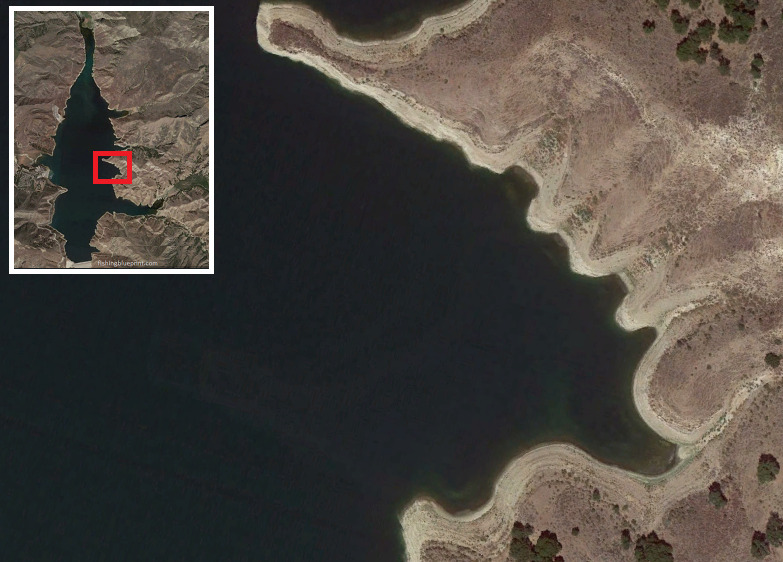
This spot is a smaller cove, however has a deep channel fed by several feeder creeks.
The secondary cuts provide great spawning pockets in the spring.
The primary points of the cover are great all year long.
Due to the extremely low water levels large amounts of grass, brush, and small trees have grown where the lake water once held. Fortunately, this provides much needed cover for smaller fish and young bass to seek shelter.
Scan the intersections for ledges, drop offs, boulders, rock piles, ridges associated with the two intersecting channels.
Located: west lake
Structural features: submerged and emergent brush and trees, spawning pockets (when water is at full pool)
Best species to target: largemouth bass, catfish, crappie
Most effective way to fish this spot: boat, kayak
Diablo Cove
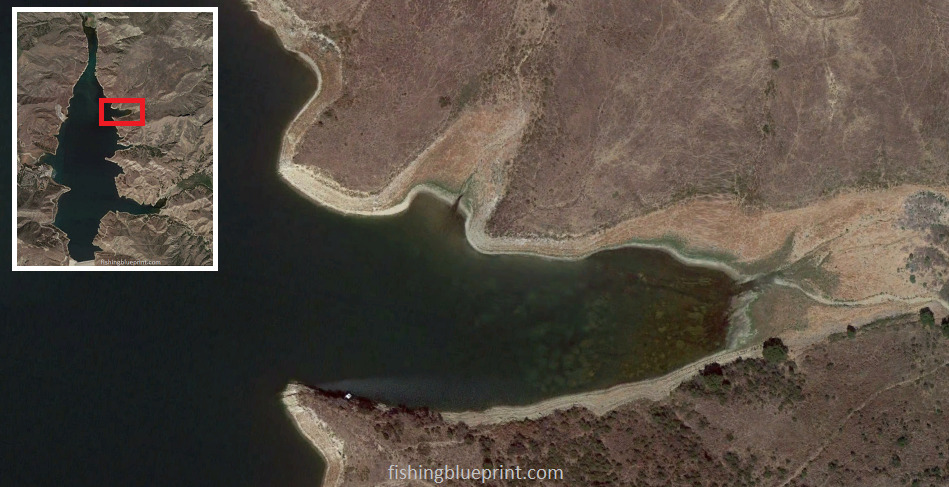
This long straight cove has a deep channel fed by several feeder creeks.
A really great feature about this cove is there is one main creek channel that runs down the middle of it, however there are several other ditches (smaller secondary creek channels).
Due to the extremely low water levels large amounts of grass, brush, and small trees have grown where the lake water once held. Fortunately, this provides much needed cover for smaller fish and young bass to seek shelter.
Scan the intersections for ledges, drop offs, boulders, rock piles, ridges associated with the two intersecting channels.
Lastly, a tire reef has also been placed at the mouth of the cove on the north side.
Located: south lake
Structural features: submerged and emergent brush and trees, artificial structure.
Best species to target: trout, largemouth bass, catfish, crappie
Most effective way to fish this spot: boat, kayak
Boat Ramps at Lake Piru
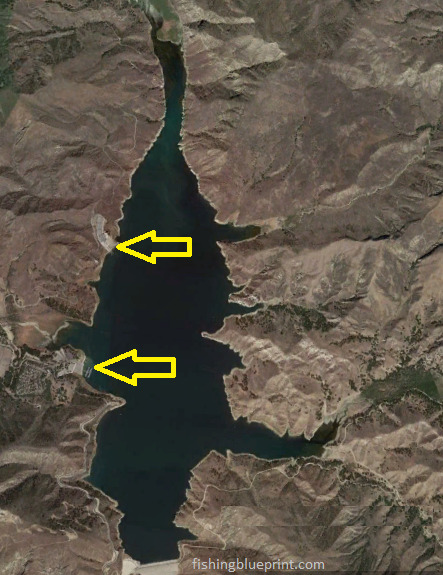
Lake Piru Recreation Area
4780 Piru Canyon Rd, Piru, CA 93040
1(805) 521-1500
Lanes: 7
Groceries available: no
Gas: no
Bathrooms: yes
Showers: no
Electric: no
Camping nearby: yes
Juan Fernandez Launch Ramp
Lanes: 5
Groceries available: no
Gas: no
Bathrooms: yes
Showers: no
Electric: no
Camping nearby: yes
Tackle Shops Near Lake Piru
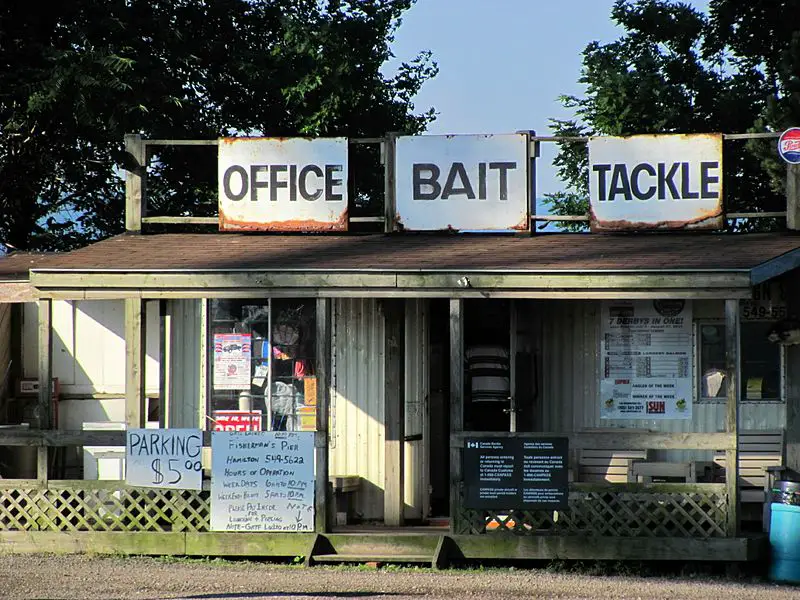
Tackle Express
22941 Soledad Canyon Rd, Santa Clarita, CA 91350
tackleexpress.com
(661)2518700
Gallions Castaic Corner
31515 Ridge Rte Rd, Castaic, CA 91384
(661) 257-3523
Pyramid Lake Store
43100 Pyramid Lake Rd, Castaic, CA 91384
(661) 294-9403
Tackle Shack USA
12061 Foothill Blvd Unit A, Sylmar, CA 91342
tackleshackusa.com
(747) 274-1081
Camping Near Lake Piru
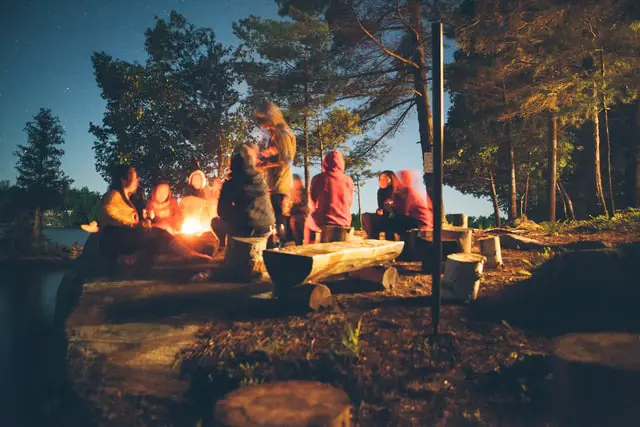
Lake Piru Recreation Area
4780 Piru Canyon Rd, Piru, CA 93040
1(805) 521-1500
- Sites – 238 total.
- RV and traditional tent sites available.
- Dump station available: Yes
- Low season: October – March
- High season: April – September
- Day use area: yes
- Pets welcome: yes
- Dog park: yes
- Drinking water: yes
- Picnic tables: yes
- Fire rings: yes
- Showers (paid): yes
- Laundry facility (paid): yes
- Campground map – click here
- Reservations – click here
Other California Related Fishing Articles
- Bass Lake Fishing Report
- Clear Lake Fishing Report
- Castaic Lake Fishing Report
- California Delta Fishing Report
- Diamond Valley Lake Fishing Report
- Don Pedro Reservoir Fishing Report
- Eagle Lake Fishing Report
- El Capitan Reservoir Fishing Report
- Lake Berryessa Fishing Report
- Big Bear Lake Fishing Report
- Folsom Lake Fishing Report
- Irvine Lake Fishing Report
- Lake Almanor Fishing Report
- Lake Camanche Fishing Report
- Lake Isabella Fishing Report
- Lake Havasu Fishing Report
- Lake McClure Fishing Report
- Lake Oroville Fishing Report
- Lake Perris Fishing Report
- Lake Piru Fishing Report
- Lake Skinner Fishing Report
- Lake Tahoe Fishing Report
- Los Banos Reservoir Fishing Report
- New Hogan Lake Fishing Report
- New Melones Lake Fishing Report
- O’Neill Forebay Fishing Report
- Pardee Lake Fishing Report
- Pyramid Lake Fishing Report
- San Luis Reservoir Fishing Report
- San Vicente Reservoir Fishing Report
- Shasta Lake Fishing Report
- Silverwood Lake Fishing Report
- Trinity Lake Fishing Report
- Whiskeytown Lake Fishing Report
More articles just for you...
Funny Fishing Rules, Laws, and Regulations 2025
Crazy Fishing Laws That Will Blow Your Mind! #7 is INSANE! Strange Fishing Regulations and Laws As silly as hook and rod limits may seem,
EXPOSED! How To Use A Spinnerbait The Right Way for 2025
Are You Wondering How To Use A Spinnerbait? Or How To Work A Spinnerbait Over Grass, Logs, or Points? Well, All These Questions Are Answered
EXPOSED! Best Crankbait Colors for 2025 [Which to Buy & Avoid]
What color crankbait to use? Crankbait Color Chart I just love going into a Bass Pro Shops store and just staring at all the walls
Best Underwater Dock Lights For Fishing – 2025 Buyers Guide
Night Dock Light Fishing For Beginners Dear fellow angler, Does this sound like you? You’re someone who loves fishing but just wants to escape the
15 Best Deep Diving Crankbaits [2025 Buyers Guide – Which to Buy & Avoid]
A Complete Buyer’s Blueprint On The Best Deep Diving Crankbaits for Bass, Walleye, or Striped Bass On The Market Today Fishing deep diving crankbaits can

